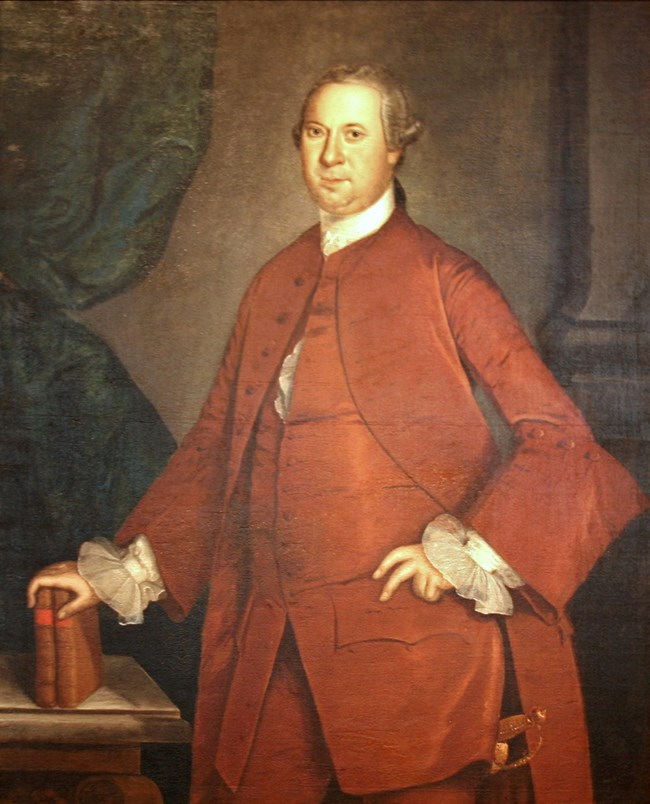Last updated: January 23, 2025
Article
Daniel of St. Thomas Jenifer

National Portrait Gallery, Smithsonian Institution
While his political reputation grew, Jenifer actively purchased land, traded in mercantile goods, bought and sold enslaved African Americans, and handled contracts for indentured servants. He invested in a shipload of about 140 enslaved men and women that arrived in Annapolis, Maryland on September 29, 1767. It is believed that one of the enslaved was Kunta Kinte, whose life was featured in the book Roots by Alex Haley.
By 1771, Jenifer was serving on the Council of Maryland’s Proprietary Governor Sir Robert Eden. Jenifer’s position initially caused animosity with other Marylanders, who were beginning to question the British Parliament’s authority over the colonies. Over the next four years, Jenifer cautiously renounced Great Britain’s rule over the colonies, but he hoped that a reconciliation would create a semi-autonomous Maryland under the nominal authority of the British Crown.
After King George III declared the colonies in a state of rebellion in August of 1775, Jenifer fully embraced his role as a patriot. His logistical and economic skills led him to become the President of Maryland’s Council of Safety, which organized Maryland’s military forces in 1775. Oddly enough, Jenifer still served on Governor Eden’s Council, and this allowed him to openly share with his fellow patriots Eden’s efforts to blunt the growing independence movement.
Soon after Jenifer’s nephew, Thomas Stone, signed the Declaration of Independence, Marylanders created the state’s first constitution. The subsequent elections saw Jenifer chosen as the President of the Senate, one of the most powerful positions in the new state. Despite being part of the gentry, Jenifer astutely determined that many of his fellow senators considered themselves better than the general citizenry, and that they were not learning lessons of the abuses of the British Parliament. He noted that “The Senate does not appear to me to be a Child of the people at Large, and therefore will not be Supported by them….”
Once the Revolutionary War ended, an old rivalry between Maryland and Virginia reasserted itself. Both states claimed ownership over the Potomac River. While Maryland’s claims were stronger, the potential for profits through trade inspired many Virginians to ignore the evidence. To settle the jurisdictional issues. James Madison of Virginia proposed a meeting between the delegates of both states. The meeting eventually took place at George Washington’s home, Mount Vernon, with the Maryland delegation including Daniel of St. Thomas Jenifer and Thomas Stone. Under the guidance of Washington, the Virginians made numerous concessions to the Marylanders as cooperation appeared a better path than one of rivalry. The “Mount Vernon Compact” signaled that cooperation among all thirteen states was clearly needed. Its success led to the Annapolis Convention of 1786, which advocated improvements in interstate trade. Although the Annapolis Convention saw only five states attend and failed to accomplish its stated goals, the delegates proposed a follow-up convention to take place “May next” in Philadelphia. This is now known as the Constitutional Convention.
Daniel of St. Thomas Jenifer arrived in Philadelphia on June 2, 1787, one of the oldest delegates present. William Pierce, a delegate from Georgia to the Constitutional Convention, noted that Jenifer “…is always in a good humour, never fails to make his company pleased with him.” Although Jenifer rarely spoke in the convention, he used his good will behind the scenes to reconcile opposing views between delegates and to formulate the compromises that helped lead to the eventual signing of the Constitution on September 17, 1787.
Jenifer died on November 16, 1790, in Annapolis, but the location of his burial is unknown. While several possibilities exist, the most likely is his birthplace of Coates Retirement, which now is known as Ellerslie. Note: Ellerslie is currently a private residence. Neither the grounds nor the mansion is open to the public.
